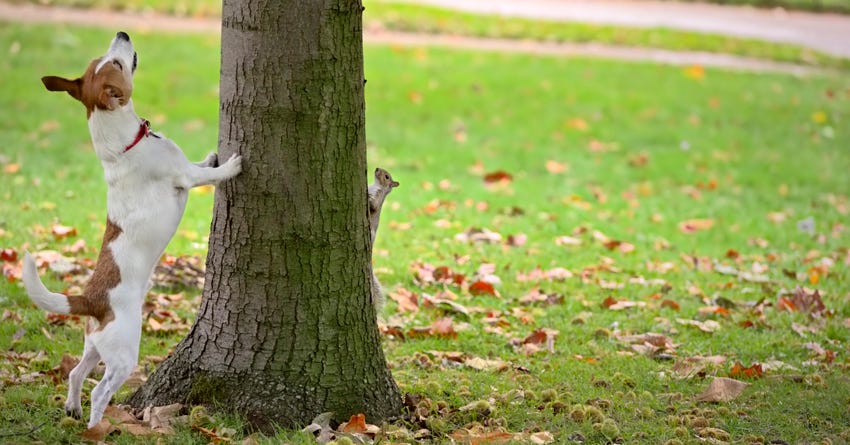Dog Training: What Are Distractions?

When you and your dog go for a walk, do squirrels, other dogs, butterflies, or even trash on the ground grab his attention?
These distractions are a part of your dog's life and can cause problems when your dog is so focused on the distraction that he's ignoring you or putting himself in danger. Just as we might get into trouble by looking at our phone while driving, your dog can get into trouble if he ignores your call for him to come to you while he's focused on the squirrel in the park. Even though distractions are a part of life, let's take a look at them and then figure out how to work around them.Distractions Vary from Dog to Dog
My youngest dog, Bones, an English Shepherd, is unfazed by most things. He has excellent natural concentration skills and I started working with him to focus those skills when he was a puppy and continued that training on into adulthood. However, when my oldest dog, Bashir, an Australian Shepherd, was a puppy, he was easily distracted. He would look away from me to watch a butterfly flit past. He'd howl with the fire truck's siren and he was particularly interested in those wonderful smells in the grass. Tennis balls, flying discs and treats were also great distractions. Other dogs will be distracted by other things. At home, the family cat can be a distraction or the overflowing kitchen trash can. Outside, another dog, a kid on a skateboard or a motorcycle driving by can garner your dog's attention. A friend's Jack Russell Terrier is totally focused on lizards. Whether something is a distraction depends on your dog at that moment and on that day.Low, High and Over the Top Distractions
Distractions are not equal. For Bashir, who is going to be 12 years old later this year, food is still a big distraction. He's learned self control and won't steal food off the table, coffee table or from the trash can; however, if there is food on the floor, that's a huge distraction. My youngest dog, Bones, isn't distracted by food much at all. So where food is a high level distraction for Bashir, it's a low level distraction for Bones. Classifying a distraction might seem to be something that makes the training process more complicated but it actually will help you in the long run. By knowing what upsets your dog's concentration the least (or the most), you can figure out what to use as a distraction during any given training session, how to use it and when. A low level distraction is something that gets your dog's attention but you can, with training and practice, get him focused on you again without too much trouble. For example, if training in a class, the treats another dog owner has might be a low level distraction to your own dog. A higher level distraction is one that has so much of your dog's attention that you need to work harder to get his attention back. Your dog may turn his back to you to stare at the distraction, may ignore your request for his attention or a treat you offer as a lure to focus his attention back on you. A high level distraction for many dogs could be picnickers and their picnic lunch in the grass at the park as you walk past. Over the top distractions are those things that send your dog into a time and place where he's no longer thinking. My friend's Jack Russell, the one who is fascinated by lizards, goes over the top if a possum is in their back yard. He turns into a quivering, shaking, yowling mess. All his instincts are telling him he must hunt that animal. If my friend were to talk to him, it wouldn't make any difference; he's that overstimulated. The only thing she can do is pick him up and remove him from that window where he can see the possum. Other dogs can become overstimulated by food, kids playing, other dogs and animals or vehicles with sirens on. Then again, for some dogs, there is nothing that is so distracting that they'll go over the top. ©istockphoto/Prensis
©istockphoto/Prensis

